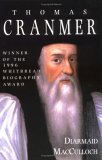
I have on my desk this morning a copy of Diarmaid MacCulloch’s Thomas Cranmer (Yale University Press, 1996). I have read it once before but feel this week an obligation to read it again—all 700 pages of it! Tomorrow (as I write, at least) is March 21 and 450 years ago (March 21, 1556), in the streets of Oxford, Thomas Cranmer was burnt alive, six months after a similar fate had befallen the two bishops, Nicholas Ridley and Hugh Latimer.
In the resurgence of Catholicism under the increasingly bitter Queen Mary, 286 men and women (some of whom were pregnant) were burnt at the stake for their avowal of Protestant and evangelical beliefs. Her tragic reign gained for her the title, “Bloody Mary.”
Thomas Cranmer (1489-1556), English reformer and Archbishop of Canterbury from 1533 to 1556 had guided the Church of England through its difficult and (for some at least) compromising steps towards reformation. Cranmer, assisted by his friend Martin Bucer, had produced two editions of the Book of Common Prayer (1549 and 1552, the former still contained much that the continental reformers found objectionable).
Cranmer’s embrace of the Protestant cause eventually resulted in his imprisonment. Cranmer’s death warrant had already been signed on February 24, 1556 (a month before his execution) and attempts were now made to cajole him into signing a recantation, which he eventually did on March 19. The following day, when it had been made clear to Cranmer that his death was to take place despite his recantation, Cranmer spent the day in apparent preparation for his death. The authorities believed they had won a major coup against the reformation and planned that Cranmer be allowed to preach a prepared sermon denouncing the reformation (which was meant to have taken place beside the funeral pyre but due to rain was held at a nearby University church instead).
For his last meal, Cranmer was given, in addition to wine and ale, spice cakes, bread, fruit and nuts and a dish of stewed prunes,” which as MacCulloch explains, “ensured that the prisoner would not suffer on a trying occasion with a bout of indigestion” (p.599).
In the morning of his execution Cranmer gave some suitable words to the prison staff, recited the litany and signed fourteen copies of his recantation (the authorities trying to ensure that no grounds of a charge of forgery would ensue). All seemed to indicate that Cranmer was playing the part the authorities had asked for. At the University church, following an address by a Dr. Cole explaining why his death was necessary despite his recantation, Cranmer began his sermon. It touched on many things, but soon made mention of “the one thing that, which so much troubleth my conscience.” The text of the sermon had already been written out and the authorities followed along as he spoke. The written text had referred to something which Cranmer had signed (meant to be a reference to Cranmer’s former denunciation of the Mass and belief in transubstantiation) but suddenly Cranmer deviated from the written text and identified the “one thing” with which his conscience was troubled—the recantation document he had signed two days previously!
The church was in an uproar. Suddenly, Cranmer was shouting his disavowal of the authority of the Pope and the doctrine of transubstantiation. At this point the authorities stopped him and removed him from the church. A graphic cartoon-like drawing appeared later of Cranmer being hauled over the pulpit by enraged authorities who marched him through the packed streets to the place of execution.
On arriving at the pyre, Cranmer was fastened to the stake by a circular metal band around his waist. The wood having been set on fire, Cranmer deliberately placed his right hand in the flames, repeatedly saying, “this hand that offendeth” and also while he could the dying words of the first martyr, Stephen, “Lord Jesus, receive my spirit.” As A. M. Renwick describes the scene, Cranmer continued “pleading for God’s pardon and the forgiveness of the people, and urging them to maintain the doctrines he had taught. He then held the offending hand and arm in the flames until they burnt to a cinder” (A. M. Renwick The Story of the Church, 134).
Thus died one “of whom the world was not worthy” (Heb. 11:38).
Tuesday, March 21, 2006
Read, mark, learn, and inwardly digest
Subscribe to:
Post Comments (Atom)



2 comments:
Peter denied Christ & repented.
Cranmer did as well.
It took courage, and God emboldened him when the time was right.
Derek,
We presbyterians tend to focus on formal doctrinal disputes and can easily miss how tremendously influential Cranmer has been through the centuries because of his work on the Book of Common Prayer.
A good analogy is for us to consider how influential our hymnals are in shaping both Reformed doctrine and piety.
In Christ,
David
Post a Comment